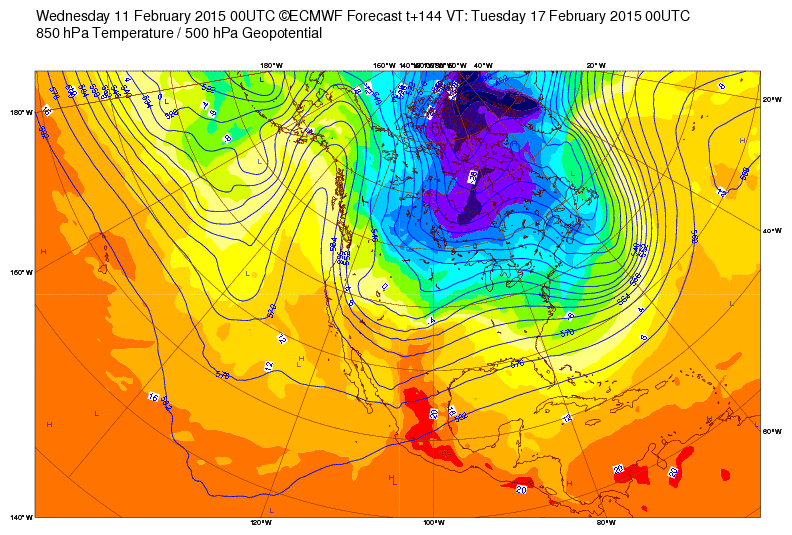A lot of people have been asking me if the warmth and poor snow this year (especially at lower elevations), as well as the string of poor snow years since 2010-11 is a long-term trend. The answer to that question is probably not, but with a few caveats, and here's why.
The climate history of the western United States is one characterized by large variability. In other words, fluctuations from wet periods (sometimes called pluvials) to dry periods (droughts) within seasons, from winter-to-winter, or even from decade-to-decade, is the way the climate behaves in the west.
If we look at the November to April snowfall history at Alta, for example, we see large ups and downs from year to year. Most years fall between about 380 and 600 inches, although there are some that are drier and some that are snowier. If you look carefully, you might even notice a bit of what we call decadal-scale variability with the early part of the period being less snowy, the 80s and 90s being quite snowy, and then a modest decline in recent years.
 |
| November-April Snowfall at Alta-Guard. Source: http://utahavalanchecenter.org/alta-monthly-snowfall. |
The last three years have been fairly lean for snow (and this year we might add a fourth, although it is not in the bag yet). The only comparable period of lean snow is from about 1958-1959 to 1962-1963 when the Nov-Apr snowfall ranged from 326-401.5 inches. And to think the phrase
Greatest Snow on Earth was coined in that period! (See chapter 1 of my book.)
Tree rings and other "proxy" climate indicators allow us to take a look at the climate farther back in time. The plot below shows estimates of the 25-year running mean flow for the Colorado River at Lees Ferry. The key thing to note here is that are some periods when the variability is relatively low (e.g., 1650-1800), and other periods with considerable fluctuations, including some extended periods of drought (e.g., 1100s).
The main point of all this is to show that the climate of the western U.S. does experience wide variability. Therefore, for me as a meteorologist, I don't find a few poor snow years to be all that surprising or necessarily indicative of a long-term trend. I also don't feel the extreme warmth this winter is indicative of what we should expect
for the next couple of decades (in italics for a reason, keep reading).
However, I said that there were a few caveats, and here are a few.
The first is what is meant by "long-term trend." If we mean a trend over say a period of a decade, then I have to plead ignorance. We do see decadal scale fluctuations in the climate of the western United States and we have made some progress in identifying the large-scale patterns that produce them and some (but less) progress in understanding their causes. We know, for example, that ocean conditions in the Pacific (including El Nino/La Nina) and Atlantic play a role, but we have a ways to go until we can reliably predict these decadal scale fluctuations. Thus, I don't really know if we are in a relatively dry period that will persist or not (those of you with an interest in this area can see the article
Decadal Scale Prediction: Can It Be Skillful?, by Meehl et al.).
If, however, we mean a trend over say a century scale or longer (in other words global warming), things get more nuanced, leading to caveat two. Let's focus first on temperatures. In my view, the extreme warmth this winter is primarily a reflection of the extremely anomalous large-scale pattern that exists over North America, as discussed in an earlier post [see
This Winter (Dec–Jan) Is Not Unprecedented]. As such, I wouldn't expect what we've experienced this year for temperatures to be the norm for the next couple of decades. That being said, global warming has and will increasingly shift the odds toward warmer winters and a greater fraction of lower-elevation precipitation falling as rain instead of snow. What you are experiencing this year will become more common eventually. December and January averaged 5.7ºF above the 1981–2010 average. You can put that into the context of future greenhouse gas emissions (Very Low to High) and the range of model projections based on those emissions (30-year periods centered on the date below with 50% of the model projections given by the lines and the extreme outliers as dots) using the plot below for the temperature change in the central Wasatch relative to 1976–2005. It lies just above the average projected for the 30-year period in 2060 under the moderate emissions scenario and near average under the high emissions scenario.
 |
| Climate model projections for the central Wasatch relative to 1976-2005. Courtesy Court Strong. |
Let's suppose these estimates of warming are overdone. Maybe we only warm 2ºF by 2060. That's fine, but the odds and frequency of years like this are likely to increase even under that scenario.
Gosh this post has gotten onerous! I still haven't discussed precipitation, but I need to get some cross-country skiing in before the snow is gone, so I need to conclude.
The bottom line is that we should not panic for the short term. The extreme warmth this year is not going to be the norm for the next couple of decades. If we're in a bad period, so be it, but I'd still rather ski here than many other places. That being said, warming is in our future and eventually it is likely going to have a growing influence on the low-elevation snowfall and snowpack. For more details, and discussion of the upper elevations, see Chapter 9 of my book.
























.jpeg)





























